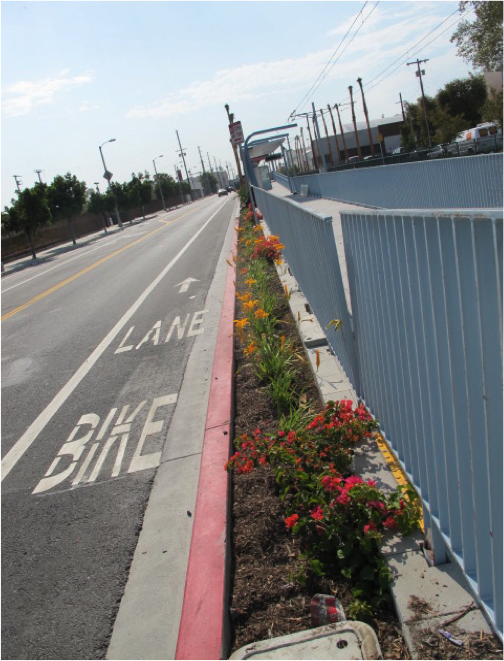Anyone who reads my tweets as well as my posts and comments on this blog and elsewhere knows I am hardly a fan of the Los Angeles Metro’s Board of Directors decision to install turnstiles at its unmanned rail stations. Needless to say, I pay attention to any developments on the issue, and while Damien might not have noticed this report on this week’s Metro Board of Directors’ Committee Meetings, I did. Even if you don’t care one way or the other about the turnstiles, if you are interested in complete streets, you may want to pay ongoing attention to this.
Because this fetishism may end up ruining a newly created bikeway for cyclists in Los Angeles and Culver City.
In response to a request made in July last year by Los Angeles County Supervisor Zev Yaroslavsky, and joined City of Santa Monica Councilmember (and current Mayor) Pam O’Connor and City of Glendale Council Member Ara Najarian, all three of whom currently sit on the Metro Board of Directors, Metro staff was directed on July 25, 2013 to come up with a report describing the feasibility of installing turnstiles and fare gates at all stations including those stations on the Light Rail Transit (LRT) network (Blue, Gold and Expo Lines)* which being by definition “Light”, had not been designed to accommodate fare-collection barriers.
This was done using the presumption, quoted from the Motion by Yaroslavsky, O’Connor and Najarian, (See Page 12) that:
As we've seen since we implemented gate latching in late June, the system is working smoothly and without incident. Moreover, revenues are up and we are now able to obtain true ridership numbers, where people are going, and where people are coming from, etc.
That is an interesting presumption since the initial latching of turnstiles had only happened some 34 days prior, the entire Subway or “Heavy Rail” System (Red and Purple Lines) was not latched until eleven days later on August 5th, 2013 and no conclusive data about revenues or ridership was yet available.
But since “the Emperor has a fine set of new clothes” and apparently we must order more to “take this issue head on”, so the report discussing the work that will have to be done to add turnstiles and at least one Americans with Disabilities (ADA)-compliant faregate plus the alarmed (?) emergency exits to every station and related fencing has been produced. (Each must be 60% accessible which means if the station has two entrances, then both must have the ADA-faregate).
Cycle-users will please take note the number of times the words “Lane Takes” and “incur” or “intrude” or “encroach” plus “lane” appears in the report. (The “Find” tool found under the “Edit” menu on Acrobat Reader can be used for this purpose).
The key sentence, found on page 7 of the report, is:
Similarly, widening entrances at the following stations would encroach on traffic lanes: Jefferson/USC, Exposition Park/USC, Exposition/Vermont, Exposition/Western, and Exposition/Crenshaw.
Recall please that the streets that parallel Metro’s Light Rail Lines are, in the City of Los Angeles, controlled by the move-more-cars-fixated Los Angeles Department of Transportation (LADOT). If Metro has to “incur”, “encroach” or “intrude” on the street right-of-way to do a “Lane Take” in order to install the fare-collection equipment, then let’s take a guess who will have priority over the remaining space?
After all, we’ve seen this before when other interests found bicycle lanes to be intrusive or unacceptable. Somehow even the “all-powerful bicycle lobby” never seems to be able stop it.
Am I being alarmist? Hardly.
Come April, will be two years since the Expo Line opened and LADOT still won’t even allow for trains on this line to have signal priority at intersections. Any one motorist with a working automobile gets prioritized at intersections, such as Flower and Adams or Exposition and Vermont, over a train of three light rail cars, each costing $4million (based on the current Kinki Sharyo P3010 order), potentially carrying many hundreds of passengers. And there is seemingly nothing Metro can do to get LADOT to fix this, even though trains run on iron/steel tracks that have been able to transmit the approximate location of each train through a technique that predates the arrival of the transcontinental railroad to California, and even with Los Angeles having a history of very advanced traffic signal control which LADOT claims can accommodate train movements!

So when the five above-listed surface stations need their entrances widened, like the Exposition/Crenshaw station pictured left you can be certain that it will be motorists who will be prioritized for the space that remains afterwards. Cycle-users will be lucky if even “Sharrows” remain in areas around these stations!
At aerial stations bikes will also lose, because more of the Metro-owned-and-controlled footprint under the platforms that may presently hold bike racks or bike lockers and could be used without local veto for a Metro-operated bikeshare will be taken for the new additional fare collection machinery (turnstiles, ADA-gates, emergency exits, “gate-help-phones” and fencing).
Streetsblog L.A. will continue to monitor this potential conversion of this hard-won bicycling corridor into a “Black-Diamond Trail” by the turnstile-industrial-complex, but we need regular users of the bikeway to be our eyes on the street for any indications of lane reconfigurations, takings and removals. Let us know if you see something via Twitter (@streetsblogla) or e-mail (tips@la.streetsblog.org).
*The Green Line, while using Siemens-built P2000 cars from Metro’s LRT fleet, is outfitted to run automatically (and could operate driverless) , is presently an entirely grade-separated line and is thus more correctly defined as “Light Rapid Transit Metro“ or “Pre-Metro”






